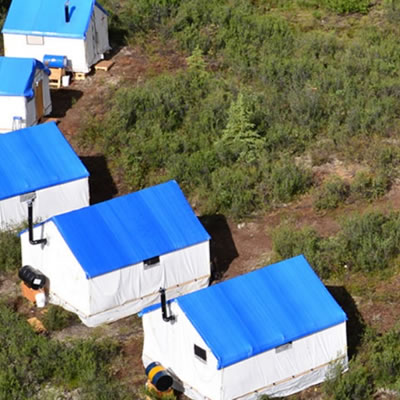Independence Gold intersects gold mineralization on Boulevard, Yukon

Aerial view of the Boulevard Project in the Yukon. — Photo courtesy Independence Gold Corp. VANCOUVER, British Columbia, Nov. 16, 2017 (GLOBE NEWSW
Aerial view of the Boulevard Project in the Yukon. — Photo courtesy Independence Gold Corp.
VANCOUVER, British Columbia, Nov. 16, 2017 (GLOBE NEWSWIRE) -- Independence Gold Corp. (TSX.V:IGO) ("Independence" or "the Company") is pleased to announce drill results from four of nine diamond drill holes completed this summer on the Company’s 100% owned Boulevard Project, contiguous to Goldcorp Inc’s Coffee Gold Deposit in the White Gold District, Yukon. The best intercept in these four holes is 3.10 grams per tonne (“g/t”) gold over 1.5 metres (“m”) including 76.2 g/t gold in the coarse fraction (24.1 g) of a 875 grams (“g”) sample over the same interval.
A total of 977.5 m of diamond drilling was completed in 9 holes within the Sunrise/Sunset Zone, located 8.5 kilometres (“km”) southwest of the Coffee deposit. Drilling focused primarily on the intersection of the Sunrise and Sunset trends which have been identified as multi-element soil geochemical anomalies and were confirmed by reverse circulation (“RC”) drilling in previous years. Significant intercepts from this year’s diamond drilling program are presented in the table below. A table of all 2017 drill results and a map showing the drill hole locations is posted on the Company’s website.
Samples from this year’s program have exhibited a nugget effect in the gold mineralization. Therefore, all samples from this program with fire assay results greater than 1 g/t gold have been further analysed by screen metallics to determine the amount of gold in the coarse fraction (greater than 106 microns) and the amount of gold in the fine fraction (less than 106 microns).
Drill holes BV17-58 and 62 were follow-up drill holes to RC hole BV16-54 which intersected 1.58 g/t gold over 39.6 m including 7.73 g/t gold over 6.1 m. BV17-58 and 62 both ended in minimally anomalous gold zones, suggesting that mineralization remains open and may continue at depth. Drill hole BV17-58 intersected 1.5m wide interval of quartz biotite schist with moderate to strong silica alteration associated with multiple 0.5-4.0 centimetre wide cross-cutting quartz veins. Disseminated pyrite was observed throughout the interval while stibnite was observed in association with the cross-cutting quartz veins.
Drill hole BV17-60 and 61 were follow-up drill holes to RC hole BV15-40 which intersected 15.00 g/t gold over 3.1 m including 27.90 g/t gold over 1.5 m. BV17-60 intersected a 4.5 m wide interval of quartz biotite schist intruded by white massive quartz veining with disseminated pyrite. This intercept exhibited a nugget effect which resulted in 14.03 g/t gold found in the coarse fraction during a screen metallic analysis
All four holes have azimuths that vary from 070 to 080 degrees with dips of -45 to -55 degrees. Results from the remaining fives holes, including three holes that followed-up on BV15-31 which intercepted 3.21 g/t gold over 29 m including 7.23 g/t gold over 12.2 m, are still pending.
All samples were submitted to SGS Minerals Services in Burnaby, BC for sample preparation by crushing to 75% less than 2 millimetres, creation of a 250 g split, and then pulverizing to 85% passing 75 microns. Sample pulps were submitted for a 52 element analysis using an aqua regia digest and ICP-AES and ICP–MS analysis (GE-ICM14B) and for gold analysis with a 30 g fire assay and AAS finish (code GE-FAA313). Samples resulting in greater than 1 g/t of gold were then re-submitted for analysis by screen metallics. A 1,000 g sample was taken from the reject, crushed to 2 mm and split. A representative sample of approximately 100 g was taken. This sample was pulverized and screened to 106 microns. The plus 106 micron fraction was submitted for fire assay, the minus fraction was split and two 30 g aliquots were submitted for fire assay. Final assays were weight ratioed back to the representative sample weight (code FAS51K). Control samples (accredited gold standards and blanks) were inserted into the sample sequence on a regular basis to monitor precision of results. No QAQC concerns were identified.
About Independence
Independence Gold Corp. (TSX.V:IGO) is a mineral exploration company listed on the TSX Venture Exchange. With a portfolio of projects in the Yukon and the 3Ts Project in British Columbia, the Company’s holdings range from early-stage grassroots exploration to advanced-stage resource expansion. For additional information, visit the Company's website www.ingold.ca.




